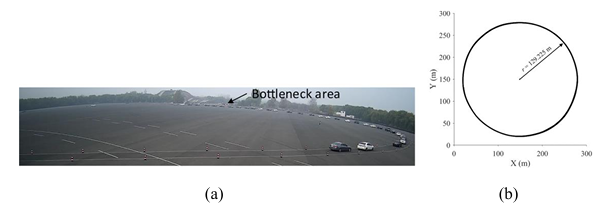Introduction
The Fixed bottleneck experiment (Speed-limited area) was performed on Nov. 9, 2019, in the test field affiliated to Research Institute of Highway, Ministry of Transport, China. A circular road track with circumference 812 m including a 30-meter speed limit bottleneck was used as the test site. See Fig. 1(a) for the snapshot of the experiment. The trajectories of cars measured by the GPS installed on the cars were shown in Fig. 1(b).

High precision GPS devices have been installed on all the cars to record their locations and velocities every 0.1 s. The measurement errors of the GPS devices are within ±1 m for location and within ±1 km/h for velocity. Initially the vehicles stop bumper-to- bumper, then the cars are instructed to move through the walkie-talkie. The drivers were instructed to simulate peak-hour driving behaviors by maintaining close-following distances with preceding vehicles while strictly adhering to safety constraints, replicating congested freeway conditions. Two runs were conducted in the experiment, the limit speed in the bottleneck area is set to 20 km/h and 10 km/h, respectively. The trajectories of the vehicles was shown in Fig. 2.
References:
Zheng Shiteng, Jiang Rui*, Tian Junfang*, Li Xiaopeng, Treiber Martin, Li Zhenhua, Gao Landa, Jia Bin, 2022. Experimental and empirical study on the growth pattern of traffic oscillations upstream of a fixed bottleneck. Transportation Research Part C, 140, 103729.
Download


